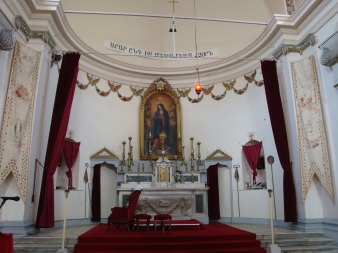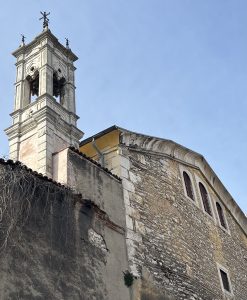“Big Mustafa Paşa” (?)
Just inland from the Sea of Marmara coast road once it passes Yenikapı is Kocamustafapaşa, the official modern name for Samatya, a district unusually still known to many İstanbullus by its original Byzantine name. This is an area that has reinvented itself as a second Kumkapı, with an ever expanding choice of fish restaurants and meyhanes ringing the picturesque main square. Unusually full of Greek Orthodox and Armenian churches, a few of them still in use today, it’s also a neighbourhood that has proved very popular with TV film producers, making it the Kuzguncuk of the European side of İstanbul. But whereas Kuzguncak still retains a fair number of pretty old wooden houses, Samatya is solidly modern apartment blocks, albeit apartment blocks with stunning sea views from their top floors.
Backstory
In an attempt to revive the area, Samatya was resettled with Armenians from Bursa after the Conquest of Constantinople and soon found itself locked in combat with the local Greek community for possession of the historic Sulu Manastır (Water Monastery), a church that had stood inside the Samatya Gate in the Propontine Sea Walls since early Byzantine times. The quarrel became so heated that the church came to be nicknamed the Kanlı Kilise (Bloody Church). Today it’s firmly in the hands of the Armenians although the patriarchate is now based down the road in Kumkapı. Even today a sizeable Armenian community lives in Samatya.
Around Samatya
If you approach from the waterfront or the train station you pass through what was once the Samatya Gate in the Propontine Sea Walls to get to the main square. Just inside the Gate are the remains of the Büyük Kule, a tower from the old walls.
If instead you continue walking along the walls on the sea side you will come eventually to the 19th-century Armenian Church of Surp Hovhannes (John the Baptist) behind which are concealed the original Narlıkapı (Pomegranate Gate) and an unrestored stretch of the old wall.
Walking gently uphill from the Samatya Gate you will come to the picturesque main square and its gathering of meyhanes. Some of the restaurants such as Develi have been here forever, while others are Johnny Come Latelys that have yet to reveal whether they have the necessary staying power.
 Interior of Hagios GiorgiosBear left at the side of the square and follow the winding roads uphill to find the two (locked) 19th-century Greek Orthodox churches: Christou Analipsis and Hagios Nikolaos.
Interior of Hagios GiorgiosBear left at the side of the square and follow the winding roads uphill to find the two (locked) 19th-century Greek Orthodox churches: Christou Analipsis and Hagios Nikolaos.
When you reach the narrow main road that runs through Samatya turn right to find the externally plain Armenian Church of Hagios Giorgios which still offers Sunday services.
Past this church stands the Greek Orthodox Church of Hagios Menas, a recent rebuild of a church dating back to 1833 that was destroyed during the anti-Greek rioting of 1955. Beneath it lurks a truly venerable relic: the outer wall of the Mausoleum of Sts Karpos and Papylos, obscure Romans who were martyred for their faith duing the 3rd-century Decian persecution of the Christians. Sadly, you can only glimpse a small stretch of circular wall behind the local teahouse if permitted to do so by the owner.

Nearby on Cambaziye Mektebi Sokak stands the double hamam of Kapıağası Yakup Ağa Hamam which was designed by Sinan in c.1550. Completely restored, it now features a hyper-modern glass-and-steel dome.
Alternatively you can turn left at the main road and walk west towards Yedikule until you come to a street on the left signed for the Church of St John the Baptist of Studion. This church was originally built between 454 and 463 making it older than both Hagia Sophia (Ayasofya) and the Church of Sts Sergius and Bacchus (Küçük Ayasofya). Of that original building, however, little survived its destruction during the Fourth Crusade of 1204 and a subsequent rebuild in 1293. After the Conquest it was converted into the İmrahor İlyas Bey Cami which was, in turn, destroyed by an earthquake in 1894.
Unfortunately although the church has long been a designated museum you always needed to apply to the authorities at Ayasofya for permission to view the Byzantine mosaic floors that still survived inside (the most beautiful are in any case on display in the Benaki Museum in Athens), not an option available to most casual visitors. In 2024 restoration work was underway but if recent experience is anything to go by that probably means that the church will be rebuilt as a mosque and the mosaic floors will vanish under a carpet. Before turning away, spare a thought for the days when thousands of monks lived in this neighbourhood, busily turning out stunning illuminated manuscripts under the stewardship of Abbot Theodore the Studite (759-826).
While in this part of Samatya you might also like to take a look at the Greek Orthodox Church of Sts Constantine and Helena, built in 1805. Its congregation was almost entirely made up of immigrants from the province of Karaman in Central Anatolia who wrote their Turkish in the Greek script, a linguistic aberration known as Karamanlı.
To find the much-fought-over Kanlı Kilise (actually Surp Kevork or the Sulu Manastır (Water Monastery) ) you need to head inland behind Hagios Menas. The monastery was originally the Greek Orthodox Church of Panagia Peribleptos, built in 1031 and destroyed, like the Studion Monastery, during the chaos caused by the Fourth Crusade in 1204. It, too, was restored once the Byzantines were reinstated but unlike the Studion it continued as a Christian place of worship after the Conquest when Sultan Mehmed II gave it to the Armenians who had been settled here. Today the church, restored yet again in the 1990s, stands in a walled compound together with an Armenian school that is still operating. In the grounds there is also an ayazma (sacred spring).
Off Kocamustafapaşa Caddesi is a busy square where many buses terminate. Here, too, is the inconspicuous Ramazan Efendi Cami, the last work of Sinan, designed in 1586 when he was ninety-six. It contains a fine collection of İznik tiles although you may only be able to get inside to inspect them around prayer time on Friday.
A short walk west lies the Kocamustafapaşa Cami, better known as the shrine of Sümbül Efendi. Although it’s not obvious from the outside this mosque started life as a Byzantine church, probably dedicated to St Andrew of Crete, in the 13th century. If you go inside, turn sharp right and walk to the end of the building, then turn and look back you will find yourself in what was once the narthex looking towards what was the site of the altar in the apse; the mihrab and mimber stand in what was once the south aisle.
The tomb of Sümbül Efendi in the grounds is painted with blue hyacinths, a play on his name which is Turkish for hyacinth.
Eating
Develi1912 Samatya Renowned for its kebabs and spicy southeast Turkish cuisine, Develi is such a sophisticated operation that it can even arrange for your car to be cleaned while you dine. There are other branches about town but this was the original. , Gümüşyüzük Sokak No. 1, Tel: 0212-529 0833
Küçük Ev Restaurant on the edge of the main square that serves a full range of fish dishes. Büyük Kuleli Sokak, Tel: 0535-978 4003
Kuleli Meyhane Long-lived meyhane whose specialities include fried mussels, cured anchovies, octopus salad and a dessert made from honey, cream, bananas, strawberries and oranges called “bal-ka-muz”. Büyük Kuleli Sokak No. 32A, Tel: 0212-587 9428
Samatya Balık Evi Inviting meyhane opposite Develi that serves a great choice of mezes and decent fish to follow. Gümüşyüzük Sokak No. 6, Tel: 0212-632 2021
Transport info
There are plenty of buses from Eminönü to Kocamustafapaşa but it’s quicker and easier to take the suburban U-bahn train from Sirkeci – the station is minutes away from the square. Afterwards you can hop back onto it to continue to the castle at Yedikule.
Nearby areas


